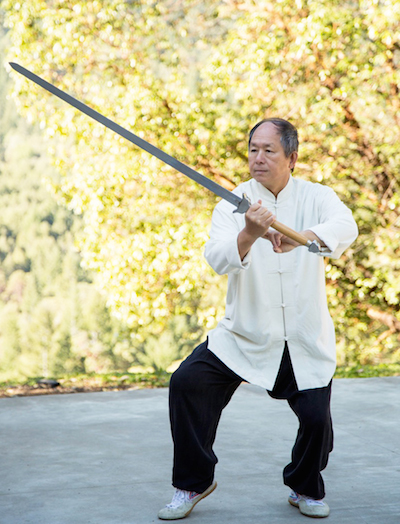

However, this section of the blade can be damaged very easily, and so is never used for locking. The upper-third (or jiànfeng) of such a blade became extremely thin and sharp, and is used for attack. Naturally, the fighting style also evolved along with the weapon, with increasingly refined and circular techniques. The most modern example of this evolution divides the blade into three distinct segments, but the weapon remains light enough for one-handed use. Over time, styles of jian became more specialized as jians started to be used not just on the battlefield, but also for duels jian use in duels naturally demanded a more versatile blade. Today, these swords are housed in the Museum of the Mausoleum of Nanyue King, Guangzhou, China.

All of these have long blades, the largest measuring 146 cm, and most are designed to be wielded two-handed. The picture below shows five jians dating to the Han Dynasty. These symbolic blades were important enough that some officers and emperors of this period were even buried with their weapons. Nevertheless, the jian remained an important symbolic weapon for high-ranking military officers, who were decorated with jians to represent their status. However, jians began to fall out of favour during this period as single-bladed sabres, which were the standard for cavalry but which were also easier to produce and learn to handle, gained favour. It has been speculated that the fighting techniques were derived from the use of spears, which were some of the most widely-used battlefield weapons of the day.ĭuring the Han Dynasty (206 BCE - 220 CE) the Chinese evolved their forging techniques further, developing the technique of metal bending (sometimes called metal folding), which allowed for lighter, sharper, and more durable blades. At the beginning of this period, the use of a jian was more focused on stabbing than cutting, taking advantage of the sharpened tip of the sword. This technique was refined over time, and continued to be applied as forging shifted from bronze to iron and steel construction.ĭuring the Qin Dynasty (221 BCE - 206 BCE), China continued to hone their forging techniques and to refine their system of using metal alloys for the creation of longer swords. This allowed for the forging of a jian with a more flexible interior of softer metal, with an exterior of harder metal intended to receive and maintain a sharp edge. One of the most famous techniques which allowed for the evolution of the jian into its longer form was the combining of two or more bronze alloys of differing hardness, forged into a single blade.

The ancient Chinese were masters of both sword forging and the creation of metal alloys. However, there are earlier records of jian use within the Spring and Autumn Period (770 BCE -446 BCE), and the jian may even date back further before this period. Early examples of these larger two-handed jians had bronze blades, but as forging techniques continued to evolve, iron and steel became the norm.ĭuring the Warring States Period (501 BCE - 350 BCE) the jian came to be widely used on the battlefield. As forging techniques improved ever-longer blades were produced over time, the jian blade grew from 28 cm to 46 cm long. The earliest jians were much shorter than the swords we know today. While the modern form of the sword is often flexible, at times this was a rigid and robust blade, which was wielded with two hands. However, this style of sword has a proud history in many battlefields throughout history. When thinking of Chinese swords, people are most familiar with the extremely flexible swords we’ve seen in Chinese martial arts schools, which are used mainly for the study of martial arts forms. Unlike the dao (刀), which has a single-sided blade, the jian (剑) is the name of the two-bladed Chinese sword which has been used in China for over 2,500 years.


 0 kommentar(er)
0 kommentar(er)
